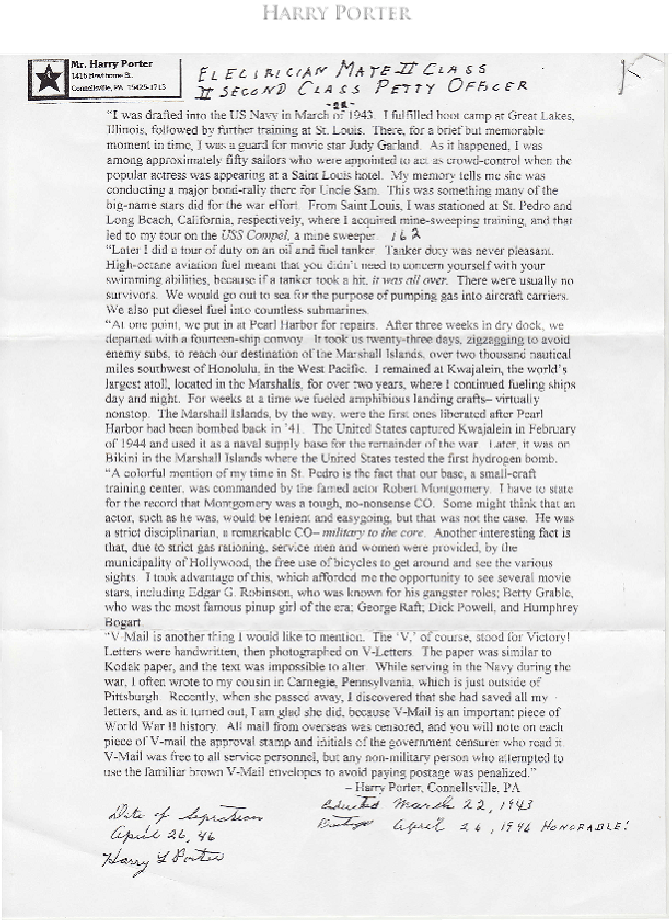Harry Porter
I was drafted into the US Navy in March 22 of 1943. I fulfilled boot camp at Great Lakes, Illinois, followed by further training at St. Louis. There, for a brief but memorable moment in time, I was a guard for movie star Judy Garland. As it happened, I was among approximately fifty sailors who were appointed to act as crowd-control when the popular actress was appearing at a Saint Louis hotel. My memory tells me she was conducting a major bond-rally there for Uncle Sam. This was something many of the big-name stars did for the war effort. From Saint Louis, I was stationed at St. Pedro and Long Beach, California, respectively, where I acquired mine-sweeping training, and that led to my tour on the USS Compel, a mine sweeper.
Later I did a tour of duty on an oil and fuel tanker. Tanker duty was never pleasant. High-octane aviation fuel meant that you didn’t need to concern yourself with your swimming abilities, because if a tanker took a hit, it was all over. There were usually no survivors. We would go out to sea for the purpose of pumping gas into aircraft carriers. We also put diesel fuel into countless submarines.
At one point, we put in at Pearl Harbor for repairs. After three weeks in dry dock, we departed with a fourteen-ship convoy. It took us twenty-three days, zigzagging to avoid enemy subs, to reach our destination of the Marshall Islands, over two thousand nautical miles southwest of Honolulu, in the West Pacific. I remained at Kwajalein, the world’s largest atoll, located in the Marshalls, for over two years, where I continued fueling ships day and night. For weeks at a time we fueled amphibious landing crafts-virtually nonstop. The Marshall Islands, by the way, were the first ones liberated after Pearl Harbor had been bombed back in ’41. The United States captured Kwajalein in February of 1944 and used it as a naval supply base for the remainder of the war. Later, it was on Bikini in the Marshall Islands where the United States tested the first hydrogen bomb.
A colorful mention of my time in St. Pedro is the fact that our base, a small-craft training center, was commanded by the famed actor Robert Montgomery. I have to state for the record that Montgomery was a tough, no-nonsense CO. Some might think that an actor, such as he was, would be lenient and easygoing, but that was not the case. He was a strict disciplinarian, a remarkable CO-military to the core. Another interesting fact is that due to strict gas rationing, service men and women were provided, by the municipality of Hollywood, the free use of bicycles to get around and see the various sights, I took advantage of this, which afforded me the opportunity to see several movie stars, including Edgar G. Robinson, who was known for his gangster roles: Betty Grable, who was the most famous pinup girl of the era; George Raft; Dick Powell, and Humphrey Bogart.
V-Mail is another thing I would like to mention. The ‘V’, of course, stood for Victory! Letters were handwritten, then photographed on V-Letters. The paper was similar to Kodak paper, and the text was impossible to alter. While serving in the Navy during the war, I often wrote to my cousin in Carnegie, Pennsylvania, which is just outside of Pittsburgh. Recently, when she passed away, I discovered that she had saved all my letters, and as it turned out, I am glad she did, because V-Mail is an important piece of World War II history. All mail from overseas was censored, and you will note on each piece of V-Mail the approval stamp and initials of the government censurer who read it. V-Mail was free to all service personnel, but any non-military person who attempted to use the familiar brown V-Mail envelopes to avoid paying postage was penalized.
– Harry Porter, Connellsville, PA

